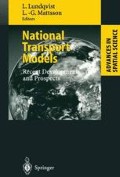Abstract
There are many reasons why national and European transport models have attracted increased attention during recent decades. The broadening of national transport policy from strategic infrastructure investments to infrastructure management with regard to efficiency, environmental, safety and regional equity objectives has lead to a need for advanced and more policy sensitive tools of analysis. The increase of interregional and international mobility requires forecasting tools that go beyond the urban or regional level. The competition for national infrastructure investments among regions and for Trans-European investments among nations has to be resolved by decisions and decision support systems at the appropriate spatial level. Environmental impacts transcend regional and national boundaries and transport policies affecting these environmental impacts involve all spatial levels.
Access this chapter
Tax calculation will be finalised at checkout
Purchases are for personal use only
Preview
Unable to display preview. Download preview PDF.
References
Abrahamsson, T. and Lundqvist, L. (1999), ‘Formulation and estimation of combined network equilibrium models with applications to Stockholm’, Transportation Science, vol. 33, pp. 80–100.
Bates, J., Ashley, D. and Hyman, G. (1987), ‘The nested incremental logit model: Theory and application to modal choice’, in Proceedings of the PTRC Summer Annual Conference, Series C, PTRC Education and Research Services, London, pp. 75–82.
Beser, M. and Algers, S. (2001), ‘SAMPERS — The New Swedish National Travel Demand Forecasting Tool’, Chapter 9, this volume.
Constantin, I., Florian, M. and Spiess, H. (2001), ‘Deterministic time table transit assignment’, Chapter 6, this volume.
Daly, A. (2001), ‘Updating and extending national models’, Chapter 3, this volume.
Eliasson, J. and Mattsson, L.-G. (2000), ‘A model for integrated analysis of household location and travel choices’, Transportation Research A, vol. 34, pp. 375–394.
Fosgerau, M. (2001), ‘PETRA — An activity-based approach to travel demand analysis’, Chapter 11, this volume.
Gaudry, M. (2001), ‘Tests of nonlinearity, modal captivity and spatial competition within the STEMM multicountry application for passengers’, Chapter 14, this volume.
Gaudry, M., Heinitz, F., Last, J. and Mandel, B. (1998), ‘Methodological development within the quasi-direct format demand structure: The Multicountry Application for Passengers MAP-1’, Bureau d’économie théorique et appliquée, Working Paper No 9815 and Centre de recherche sur les transports, Publication CRT-98–46.
Gunn, H. (2001), ‘An overview of European national models’, Chapter 2, this volume.
HCG and TOI (1990), ‘A model system to predict fuel use and emissions from private travel in Norway from 1985 to 2025’, Report to the Norwegian Ministry of Transport, HCG and TOI.
Hofman, F. (2001), ‘Application areas for the Dutch national model’, Chapter 7, this volume.
Höjer, M. and Mattsson, L.-G. (2000), ‘Determinism and backcasting in future studies’, Futures, vol. 32, pp. 613–634.
Johansson Sveder, G. (2001), ‘The new Swedish national model SAMPERS: System and validation’, Chapter 8, this volume.
Lakshmanan, T.R. (1998), ‘The changing context of transportation modeling: Implications of the new economy, intermodalism and the drive for environmental quality’, in Lundqvist, L., Mattsson, L.-G. and Kim, T.J. (eds), Network Infrastructure and the Urban Environment, Springer-Verlag, Berlin, pp. 53–71.
Lee, D.B., (1994), ‘Retrospective on large-scale urban models’, Journal of the American Planning Association, vol. 60, pp. 35–40.
Lundqvist, L. (2001), ‘A before-and-after database for land-use/transport/environment impact analysis and model validation’, forthcoming in Karlström, A. and Kaag Andersen, A. (eds), The Regional Development Consequences of Transport Infrastructure Investments — With Special Emphasis on the Öresund Bridge. Research Report, Department of Infrastructure and Planning, Royal Institute of Technology.
Russo, F. (2001), ‘Italian models: Application and planned development’, Chapter 10, this volume.
Webster, F.V., Bly, P.H. and Paulley, N.J. (eds) (1988), Urban Land-Use and Transport Interaction: Policies and Models, Report of the International Study Group on Land-Use/Transport Interaction (ISGLUTI), Avebury, Aldershot.
Wegener, M. (1998), ‘Applied models of urban land use, transport and the environment: State of the art and future developments’, in Lundqvist, L., Mattsson, L.-G. and Kim, T.J. (eds), Network Infrastructure and the Urban Environment, Springer-Verlag, Berlin, pp. 245–267.
Widlert, S. (2001), ‘National models: How to make it happen. The case of the Swedish national model system: SAMPERS’, Chapter 4, this volume.
Williams, I. (2001), ‘Designing the STREAMS model of Europe’, Chapter 13, this volume.
Williams, I.N. and Beardwood, J.E. (1993), ‘A residual disutility based approach to incremental transport models’, in Proceedings of the PTRC Summer Annual Conference, Series D, PTRC Education and Research Services, London, pp. 11–22.
Worsley, T.E. and Harris, R.C.E. (2001a), ‘GB traffic forecasts — Status and development’, Chapter 12, this volume.
Worsley, T.E. and Harris, R.C.E. (2001b), ‘General modelling approaches: Top-down or bottom-up?’, Chapter 5, this volume.
Author information
Authors and Affiliations
Editor information
Editors and Affiliations
Rights and permissions
Copyright information
© 2002 Springer-Verlag Berlin Heidelberg
About this chapter
Cite this chapter
Lundqvist, L., Mattsson, LG. (2002). National Transport Models: Introduction and Comparative Analysis. In: Lundqvist, L., Mattsson, LG. (eds) National Transport Models. Advances in Spatial Science. Springer, Berlin, Heidelberg. https://doi.org/10.1007/978-3-662-04853-5_1
Download citation
DOI: https://doi.org/10.1007/978-3-662-04853-5_1
Publisher Name: Springer, Berlin, Heidelberg
Print ISBN: 978-3-642-07628-2
Online ISBN: 978-3-662-04853-5
eBook Packages: Springer Book Archive

